If you’re looking for an email marketing software solution, then you’ve probably considered Mailchimp already. Being amongst the most popular tools, it’d make sense to keep it on your radar.
While Mailchimp is an excellent choice for small businesses, it may not be ideal for you if you’re an ecommerce business owner. So perhaps, that’s where Privy comes in for you.
Privy and Mailchimp both serve as excellent options for small businesses. However, determining which suits your needs will hinge on factors such as your business requirements, budget, and expectations.
This Mailchimp vs Privy review discusses these tools’ strengths and weaknesses in detail, giving you a better understanding of how each works.
By the end of this post, you’ll be able to decide which tool is best for your business based on its features and prices.
Let’s dive in.
Mailchimp vs Privy: Quick overview
Mailchimp has grown over the years to be an all-in-one email marketing automation platform providing a wide range of features for businesses of all kinds. We see it best suited to bloggers, startups, non-profit organizations, and solopreneurs.
Mailchimp also has many good features for ecommerce needs, but keeps them locked on the highest-tier plans. Privy, on the other hand, has more to offer for ecommerce beginners.
Take their Shopify App Store ratings, for instance. Privy has a rating of 4.6 out of 5, with over 24K reviews. On the other hand, Mailchimp has a 3.6-star rating, with only 483 reviews.
Besides being ecommerce-focused, Privy also has outstanding signup forms and displays for businesses looking to build their email contact lists.
In these following sections, we’ll compare both tools regarding their features and pricing plans.
Let’s start with a quick comparison table and see how Mailchimp vs Privy stack up as far as features go.
The above table shows that Privy and Mailchimp are neck-to-neck apart from a couple of unique features. Their distinction, however, is not apparent yet.
That’s why this next section gets into the details of each feature: so you can see how each tool works in comparison to the other.
Let’s get started.
Mailchimp vs Privy comparison: Feature by feature
We’ll compare each tool’s performance in each category and in the end announce a winner. Keep reading to find out.
Ease of getting started
The signup process for Mailchimp and Privy is easy.
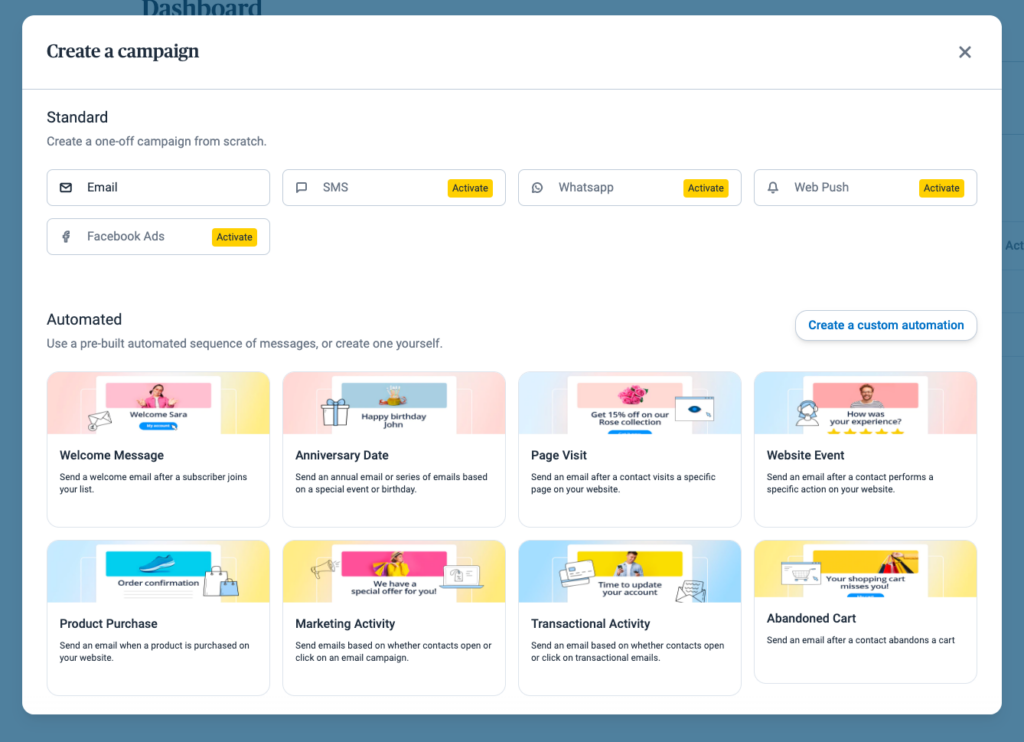
Mailchimp provides a getting started checklist to help with the initial setup, an element that can be useful for beginners. You’ll need to provide your credit card details to get started on Mailchimp’s free trial if you choose a paid plan.
No credit card is required if you start on Privy or Mailchimp’s free plan.
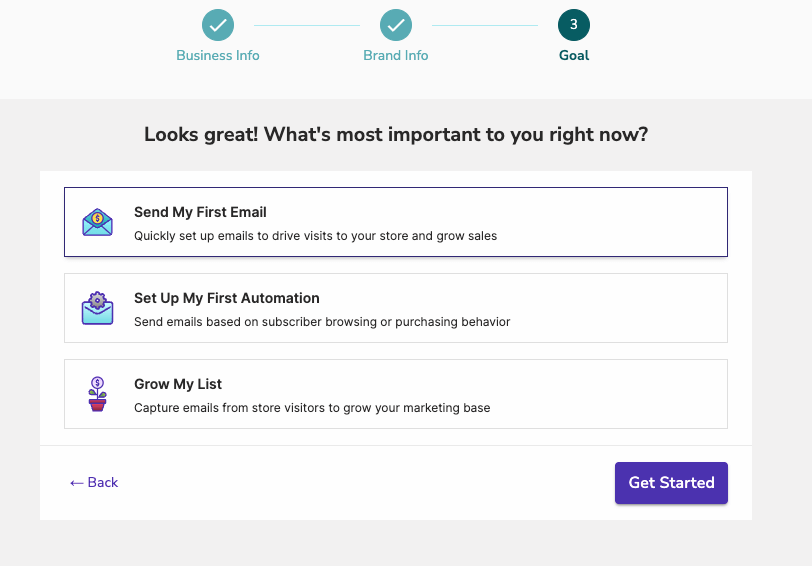
Privy’s interface is modern-looking and not too heavy. Everything is easy to find, and no unusual names for menu items exist.
Mailchimp, on the other hand, is feature-dense and users may have a hard time finding some functionalities. For instance, we couldn’t find the landing pages easily, or trace how to change a sender’s email address.
Some of Mailchimp’s vital features aren’t as easy to trace, giving Privy a bit of an edge in this round. Privy wins.
Building an email campaign
Mailchimp provides two email editor options, the classic editor and a new and updated builder. Both of them are user-friendly and hold all the standard, necessary content blocks to build your emails.
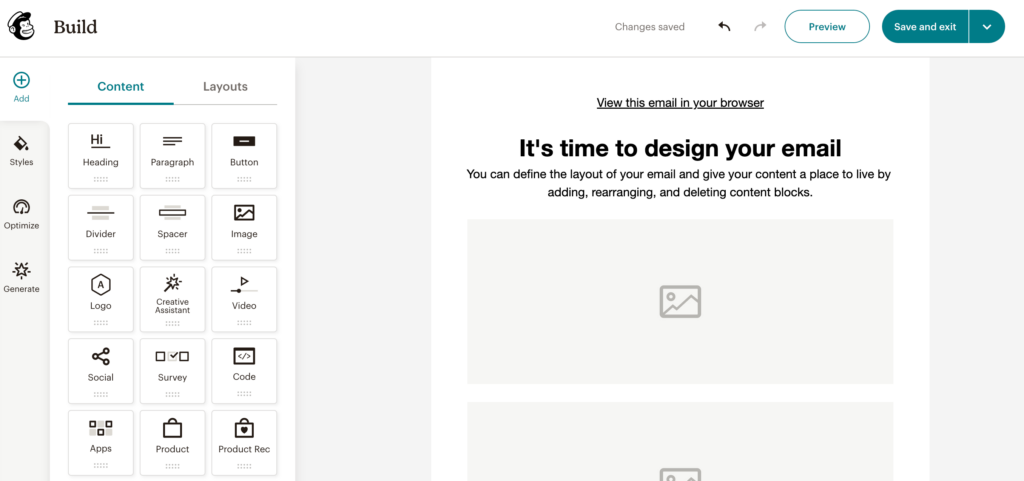
Here are some of Mailchimp’s unique features:
- Postcards: This feature allows you to send physical postcards, such as thank-you notes, to your customers. It’s a unique feature on Mailchimp that most top platforms don’t offer.
- Survey: Mailchimp lets you create and send surveys to customers to conduct marketing research or collect valuable feedback.
- Subject line recommendations: This AI-based feature helps you generate compelling subject lines for your emails based on industry best practices.
- Mailchimp’s Litmus integration: This integration allows users to preview test emails across several devices before sending them out. This way, you’ll know exactly how your messages will appear in your recipient’s inbox, whether they’re using Outlook, Gmail, etc. on mobile phones, PCs, or tablets.
Privy provides one drag-and-drop email campaign builder that’s just as easy to use as Mailchimp’s, and is aesthetically pleasing.
During signup, Mailchimp lets you upload your logo, so it can be automatically included in your future templates.
Mailchimp offers dozens of modern, unique templates, but they are only accessible on paid plans. On a free plan, you can expect plain layouts, and you’ll need to do all the design work yourself.
Meanwhile, Privy provides 20+ attractive email templates accessible even on the free plan. The only downside is that they look quite similar and might not cover all the occasions.
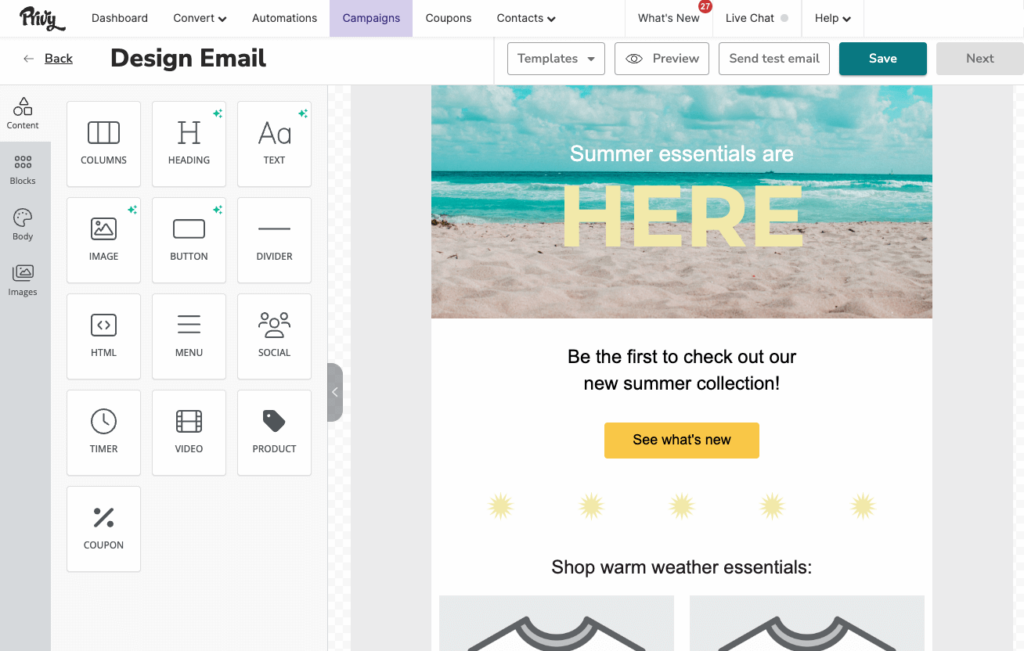
Privy also has a few unique ecommerce elements missing on Mailchimp, including:
- Product block: This feature allows you to pull products directly from your online store into your email content.
- Coupon codes: You can create unique coupon codes to incentivize your customer base to make a purchase.
- Stock images: The ability to add stock images to your email content to create attractive campaigns.
Personalization on Mailchimp is easy with its dynamic content block feature. This feature lets you send a single email to different audiences and only have them view sections of the email that are relevant to them.
However, we had to go through Mailchimp’s knowledge base to find this functionality explained. Email scheduling is also available but on paid plans only.
Both tools have unique email campaign builders suited to different business needs. However, Mailchimp provides more functionality, making it the winner in this round.
Marketing automation
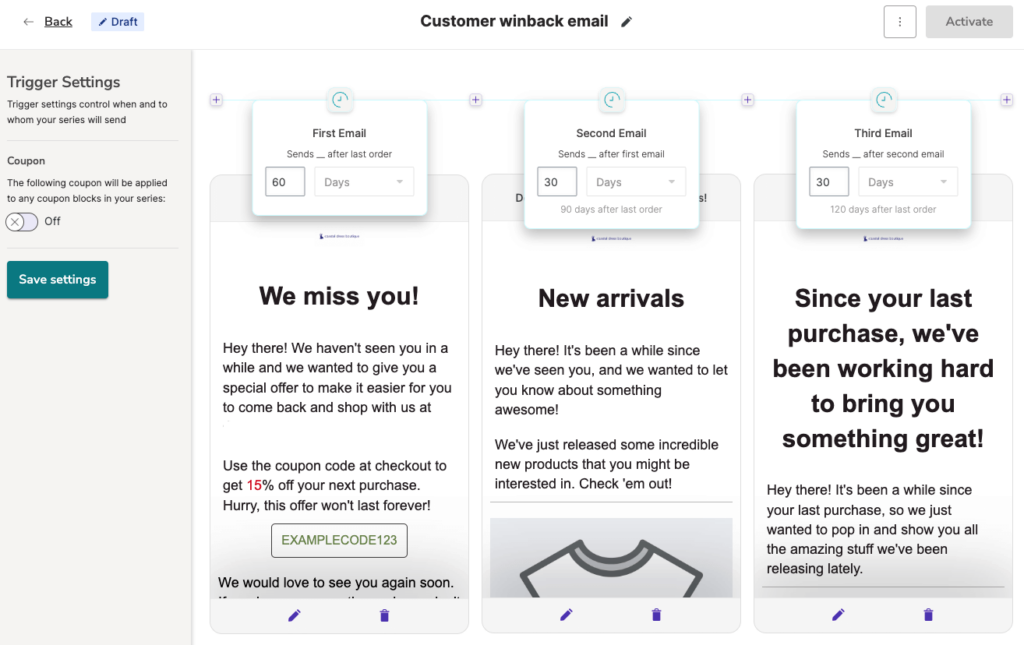
We found Privy’s marketing automation feature to be pretty limited compared to that of Mailchimp. The platform provides five ready-to-go workflows for its users, complete with both logic and copy. This, we found to be useful, especially for beginners.
However, the platform doesn’t allow users to build custom automation workflows outside of the templates provided. This is pretty limiting for experienced marketers looking to build customer journeys for different use cases.
If you’re a business that values this feature, Mailchimp looks like the better option here. With Mailchimp, there are 70+ prebuilt customer journeys. This gives you lots of use cases to work with.
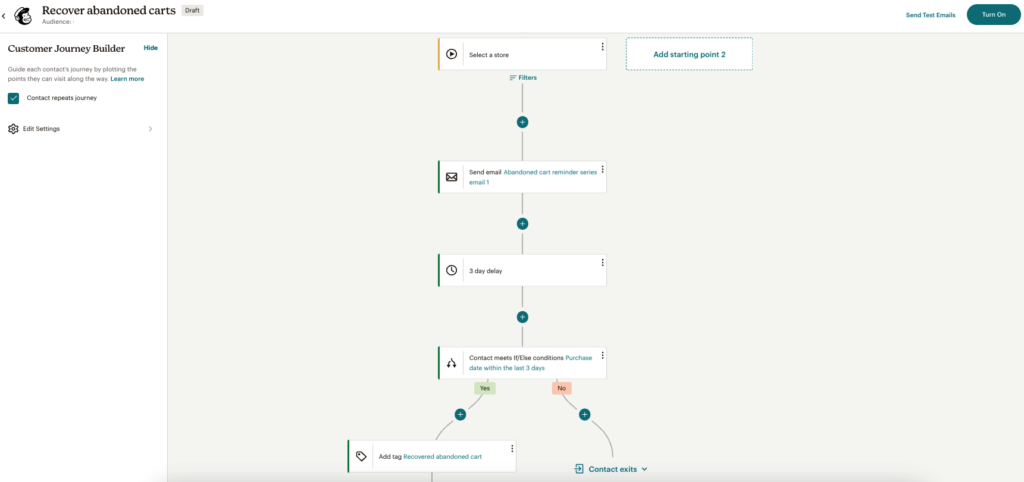
As far as other marketing channels go, Mailchimp allows you to integrate these workflows into your social media campaigns. However, unlike top email marketing platforms out there, the tool doesn’t provide native SMS and web push integration. For these channels, you will need to look for additional tools.
Privy has SMS functionality, but texts can’t be combined with emails in the same communication workflow. It’s also only available on the highest tier plan and you’d have to pay extra if you wanted to add it to other plans.
Overall, while Mailchimp’s automation feature isn’t as powerful as other platforms in the market, it’s more powerful than Privy’s.
Mailchimp wins for providing more workflows and customization options.
Signup forms and landing pages
One of the best features Privy boasts of is its list-building feature, especially with signup forms.
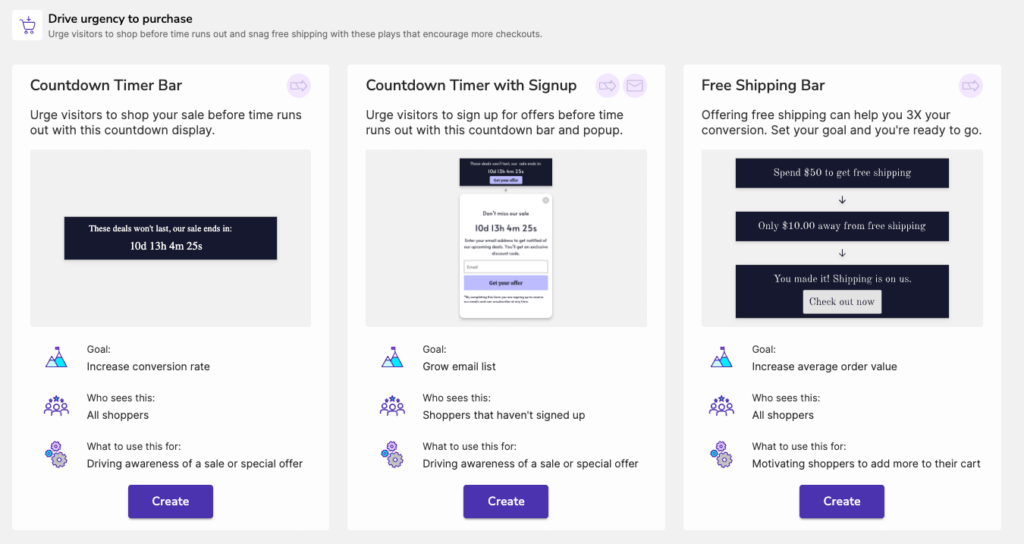
Privy compiled the best-performing popups from their customer base and made them into ready-to-go plays. These are available to all their customers and can be accessed through the Plays editor.
These popups are tried and tested, incorporate Privy’s best practices and users don’t have to worry about setup rules.
Besides these performing popups, Privy also offers many signup form designs, including gamified spin-to-win wheels.
Mailchimp doesn’t offer any prebuilt signup forms and you’d have to build everything from scratch. The feature seems pretty bleak and the form builder is pretty basic too. You can only have one popup at a time which can be limiting.
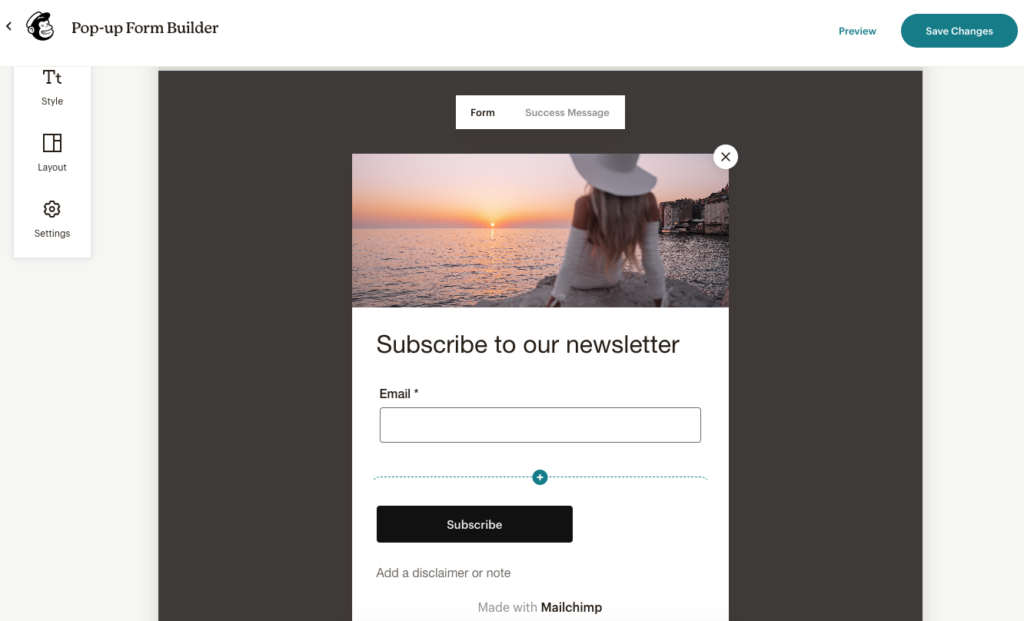
As for landing pages, Privy provides 14 prebuilt templates that you can use out of the box. These are easy to customize in the drag-and-drop landing page editor.
Mailchimp, on the other hand, provides nine landing page templates and a pretty intuitive landing page builder.
Let’s look at each tool’s list management feature.
With both Mailchimp and Privy, list management is easy. You can easily import contacts, tag, and segment lists.
The one major downside of Mailchimp is that it has siloed lists. This means that if an email address is added to two different lists, Mailchimp recognizes those as two different email addresses and you end up paying twice.
This is the case even for inactive and unsubscribed contacts.
Privy, on the other hand, takes measures to ensure you retain a quality contact list. Before any contacts are approved, Privy takes 1 to 2 days to review them to ensure there are no bad actors.
Privy wins for its outstanding signup forms.
Segmentation
Both Mailchimp and Privy appear to have strong segmentation features.
Let’s look at what Mailchimp offers. First, there are three ready-to-go audiences. These are too few, but you can create more customized ones for your use cases. You can also add up to five conditions in each segment and make them more precise.
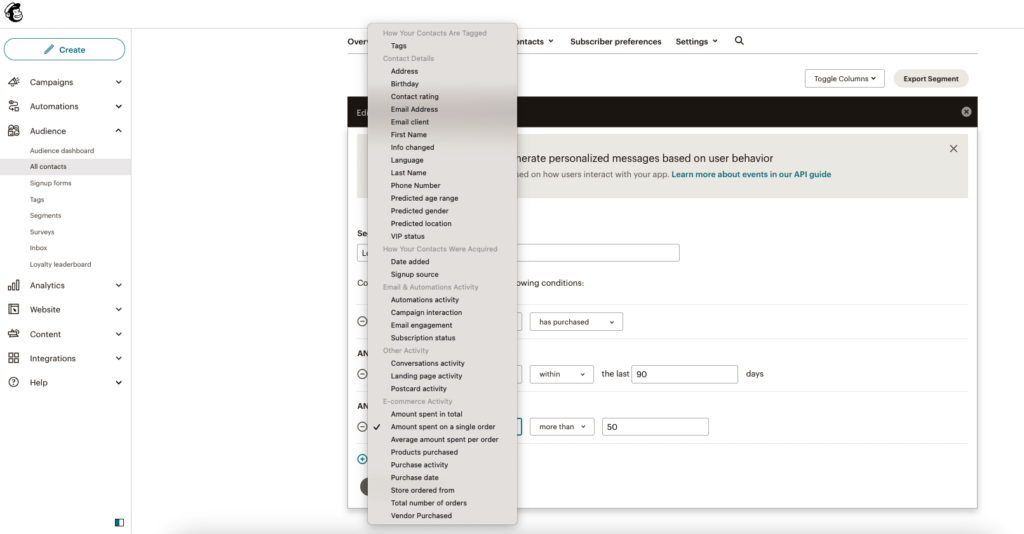
Mailchimp lets you segment your audience based on customer interests, behavior, lifetime value, demographics, and more. You can also import data from third-party tools to further improve your segments.
Privy provides four ready-to-go smart segments, including:
- Engaged customers
- Current customers
- Potential customers
- Unengaged customers
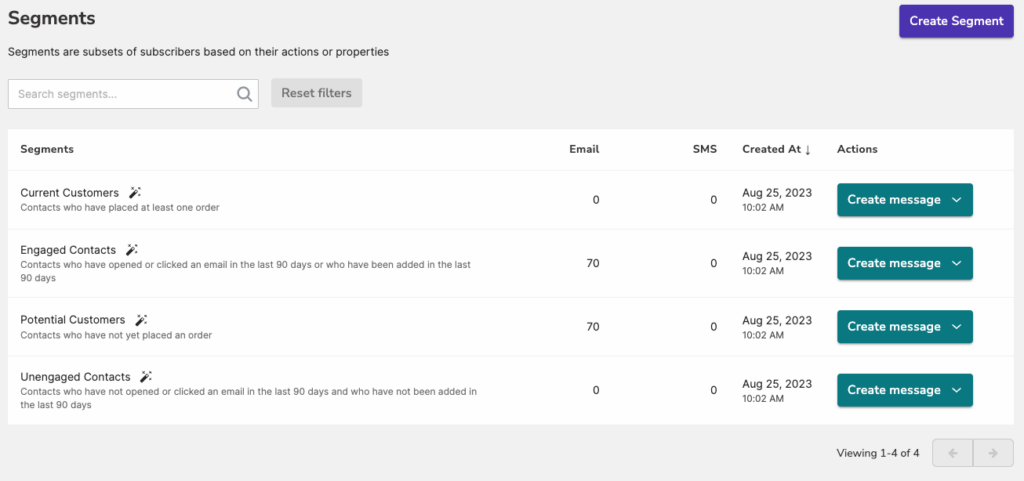
There are also numerous segmentation criteria based on items such as purchase history, order counts, shopping activity, email engagement, contact tags and so much more. The only missing criterion here is onsite behavior.
Both platforms have robust segmentation. It’s a tie.
Analytics
Businesses need data from their past performances to make better decisions for future campaigns. As such, email marketing platforms must have great reporting and analytics capabilities.
Let’s look at Mailchimp vs Privy analytics.
Privy provides the following reports for customers on their platform:
- Engagement reports e.g. clicks, opens, etc
- Subscribers and unsubscribers
- Revenue reports by email
- Revenue reports by onsite campaigns
The platform lacks some basic reports like geolocation and device reports.
Mailchimp provides endless reports, from your standard engagement and geolocation reports to social media engagement insights.
You can monitor your landing pages, conduct A/B tests on your email campaign best practices, and more. You can also know if your campaign was forwarded to other people and if they opened it.
Other reports include comparative reports, only available on the Standard and Premium plans.
Overall, both platforms lack the robust insights that ecommerce businesses need to make more data-driven decisions.
Mailchimp provides more insights. Mailchimp wins.
Customer support
Mailchimp has a few customer support options available to all their users. These vary depending on the pricing plan you’re on. Here’s what that looks like:
- Free users: Email support for the first 30 days
- All paid plans: 24/7 email and chat support
- Premium plan: Phone and priority support
We found Mailchimp’s live chat support to be quick. It took approximately two to three minutes to get a response once we tried this option.
Mailchimp also has lots of educational resources that users can access on their own. These include:
- Mailchimp 101 tutorials
- Blog
- Podcast
- Multiple YouTube videos in different languages
- Case studies
Privy, on the other hand, has fewer customer support options. Users on paid plans get email and chat support. And when you have over 9,000 email subscribers, you can get one-on-one help from a Privy ecommerce coach.
Users on the free plan have no access to customer support. They can, however, enjoy the following resources:
- Privy blog
- Marketing podcast
- Privy Help Center
Mailchimp offers support to all customers as well as an endless list of thoughtful resources. Mailchimp wins.
Integrations
Mailchimp features just about any application you can think of in its extensive list of integrations. There are over 300 applications on this list, including
- Analytics tools e.g. Klipfolio
- Ecommerce platforms e.g. Shopify, WooCommerce, BigCommerce
- Customer service platforms like Zendesk Activity
- Design tools like Canva
- Accounting platforms such as QuickBooks
Privy only has a list of eight integrations on its list. Luckily, among them is seamless integration with Shopify and other top ecommerce platforms like Wix and BigCommerce.
Mailchimp wins as it has so much more to offer in terms of integrations.
Compatibility with other marketing channels
Privy provides SMS marketing as a separate feature that you pay extra for on the Free and Starter plans. The feature comes as part of the Growth plan. The only downside is that you can’t integrate into your email workflows.
Mailchimp is compatible with several other marketing channels including:
- Google Analytics etc
However, for SMS, you will need a third-party integration.
Mailchimp has integrations to more marketing channels, making it the winner in this round.
Mailchimp vs Privy: Price Comparison
As we wind up this Mailchimp vs Privy review, another important aspect to consider while choosing your email automation platform is the cost.
While every business wants to improve their marketing campaigns, not all have the budget for it. So you must choose a platform that fits your budget but, more importantly, provides value for your money.
So which tool fits this criteria, Mailchimp or Privy?
Let’s find out.
Free plans comparison
Both Mailchimp and Privy provide free plans. Just like most platforms in the market, the features are limited.
Here’s what Privy vs Mailchimp provide in their free plans.
Now let’s look at the paid pricing plans.
Paid plans comparison
Mailchimp offers three tiered paid plans, namely Essentials, Standard, and Premium. The Essentials plan is affordable, but the features are pretty limited.
The Standard plan is more feature-packed, and relatively affordable too. There’s a high price jump into the Premium plan and only a few additions regarding features.
Privy provides two paid plans, the Starter and Growth plans. Privy’s Growth plan is more expensive compared to Mailchimp’s Standard plan.
Here’s everything in a nutshell.
Which tool gives you more value for your money?
Overall, Mailchimp’s list of features is pretty extensive. From AI-assisted subject line recommendations to postcards and dynamic content, businesses can explore more functionalities on a single platform at affordable rates.
It’s a bit different with Privy.
Aside from list building, Privy’s features are fewer and seem less powerful in comparison. Even the ecommerce features available aren’t as extensive or robust as those of specialized ecommerce tools like Omnisend.
So it would appear that Mailchimp offers more value for your money especially if you’re not an ecommerce store owner. As already established, Mailchimp’s features aren’t as advanced enough for ecommerce businesses either.
Privy vs Mailchimp: Which one wins?
Which tool wins, Privy or Mailchimp? Before we give you our final verdict, here’s a quick recap of everything we’ve covered so far.
4.1
3.7
Free plan: Yes
500 subscribers – $13
1,000 subscribers – $13
5,000 subscribers – $69
10,000 subscribers – $100
50,000 subscribers – $350
100,000 subscribers — Not available on the Essentials plan.
Free plan: Yes
500 subscribers – $30
1,000 subscribers – $30
5,000 subscribers – $105
10, 000 subscribers – $180
50, 000 subscribers – $570
100, 000 subscribers – $870
– A 30-day free trial where you can test out the majority of paid features except multivariate testing, advanced segmentation, and comparative reporting.
– 1000 email sends/mo
– a few basic email templates
– 30 days email support
– Forms and landing pages
– Basic reporting
– Up to 100 mailable contacts
– Access to all popup types
– Advanced popup targeting
– Sync with Email Service Providers
– Sync with Shopify coupons
– A very wide range of features
– Lots of integrations and can be easily integrated into any toolkit
– User friendly
– An extensive list of signup forms
– Advanced signup forms functionality
– An intuitive interface and email builder
– Easy to use
– Has robust segmentation
– Mailchimp charges for email duplicates, so you’d pay extra if you had the same subscriber in different lists.
– Very limited Free plan, and paid plans get expensive quickly
– Email templates on the Free plan are too basic for current ecommerce needs
– Automation feature is basic
– Can’t integrate email and SMS in one workflow
– Incomplete reporting feature
– Solopreneurs
– Startups
– Bloggers
– Non-profit organizations
– Ecommerce beginners focused on growing their contact list
– Bloggers
– Ecommerce stores that are in their active growth stage
– Established ecommerce businesses
– Companies with large contact lists
Back to the burning question: Mailchimp vs Privy, which one wins? The answer is that it depends.
If you’re an ecommerce beginner, you want to get your store started with Privy over Mailchimp.
This is because, besides helping you build your list, Privy provides lots of ecommerce-focused features such as coupons and abandoned cart alerts that will help improve your online store performance.
Conversely, if you’re looking for a powerful tool to send newsletters, build lasting relationships with your customers, and improve conversions, then Mailchimp would be ideal.
Mailchimp and Privy are built with smaller businesses in mind, so they may not eventually be enough as your business scales.
Read full reviews
Our team strives to be accurate and unbiased in reviewing email tools. However, we recognize that mistakes can happen, and it’s essential for us to stay up to date. If you come across any errors or things that need to be reviewed again, please let us know.





Leave a Reply